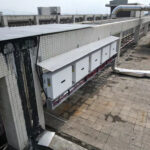There are five distinct types of solar inverters, and each of them comes with different perks.
This type of solar inverter is enormous and utilized for systems that call for megawatts or hundreds of kilowatts of volume. It is not designed for residences and looks like a huge metal cabinet; each cabinet is tough enough to manage roughly 500 kilowatts of power. Central inverters are usually utilized commercially for utility-scale solar farms and large-scale installations.
This model is the most typical inverter alternative that you could use for homes. In general, there’s one string inverter per solar setup.
Its name is derived from the fact that a string of solar panels is attached to it.
This one is the most outstanding choice if you need to fit a battery in your solar panel system. Also, it’s ideal if you prefer to keep the battery separate from the panels and run via a different inverter. Wherever possible, this inverter type transforms the battery power into 230 AC and sends it into the switchboard.
This type of inverter is as tiny as the size of a book. The solar panel to microinverter ratio is 1:1. Compared to other types of solar inverters, this version is adept at maximizing each solar panel individually.
The best thing about it is that it can supply more energy in overcast conditions.
This option lets you attach the batteries to your solar panel system. Hybrid inverters interact with the linked batteries via direct current coupling. DC coupling occurs when the batteries and solar utilize a single inverter and the direct current from the panels charges the batteries through the DC charger. In line with this, multimode inverter electronics arrange the discharging and charging of your battery.

Solar inverters are not a “one size fits all” type of equipment in terms of pricing. It is difficult to determine the precise cost of an inverter because many solar firms include the expense of the inverter in the overall cost of a solar power system. This is because inverters are crucial to solar power systems.
Anyhow, you can encounter standalone inverters online; nonetheless, the price range can be between $1,500 and $20,000. They are pretty costly because there’s plenty of cost factors involved, including the following:
The price will likely change depending on where you buy the inverter because of the product’s availability, shipping cost, and taxes.
Primarily, since several solar firms incorporate the expense of the inverter in the overall expense of the solar power system, your buying options would be limited to third-party retailers.
Essentially, your solar agreement will govern how you pay for your solar system. Furthermore, it is founded on the agreement options in your region.
Typically, the bigger the solar energy system you have, the better your inverter’s performance will need to be. Please remember that if you prefer equipment that could last for years, you should be careful about the cost without compromising quality.
A few solar inverters are engineered with exclusive built-in features like smart functionality/settings, secure power supplies, revenue-grade meters, etc.
Yes, solar inverters can last long with proper care and maintenance.
Solar inverters usually call for regular replacement every five to ten years. Regularly inspecting them can help extend their service life.
If you suspect that your solar inverter is having a problem, see if it has a green or red light. Most inverters will show a solid green light when they’re functioning correctly and generating energy during the daytime.
On the other hand, they will display a red light when they’re in a sleep mode at nighttime. So, once you notice that the inverter displays a solid red light during daylight, this means that there might be something wrong.
Check the solar inverter’s user guide to figure out the specific error code. If you think you can’t repair it yourself, consider contacting a professional to work on the repairs needed. We strongly suggest that you select a trusted installation firm to fit or inspect your solar inverter.
Every home and commercial property has different solar requirements. An excellent means to work out what type of solar inverter you require is to compute the amount of power you’d typically need.
It’s worth noting that photovoltaic inverters are regarded as the brains of solar power systems. Thus, without them, the entire solar energy system cannot function as expected.
The primary functions of solar inverters include:
ularly inspecting them can help extend their service life.



Get A Quote